Where to Buy Beef Plate Ribs Online
This step-by-step guide walks you through all you need to know and the questions to ask when buying a cow directly from a farmer. Once you know how to buy a cow, you'll wonder why you didn't do it sooner!
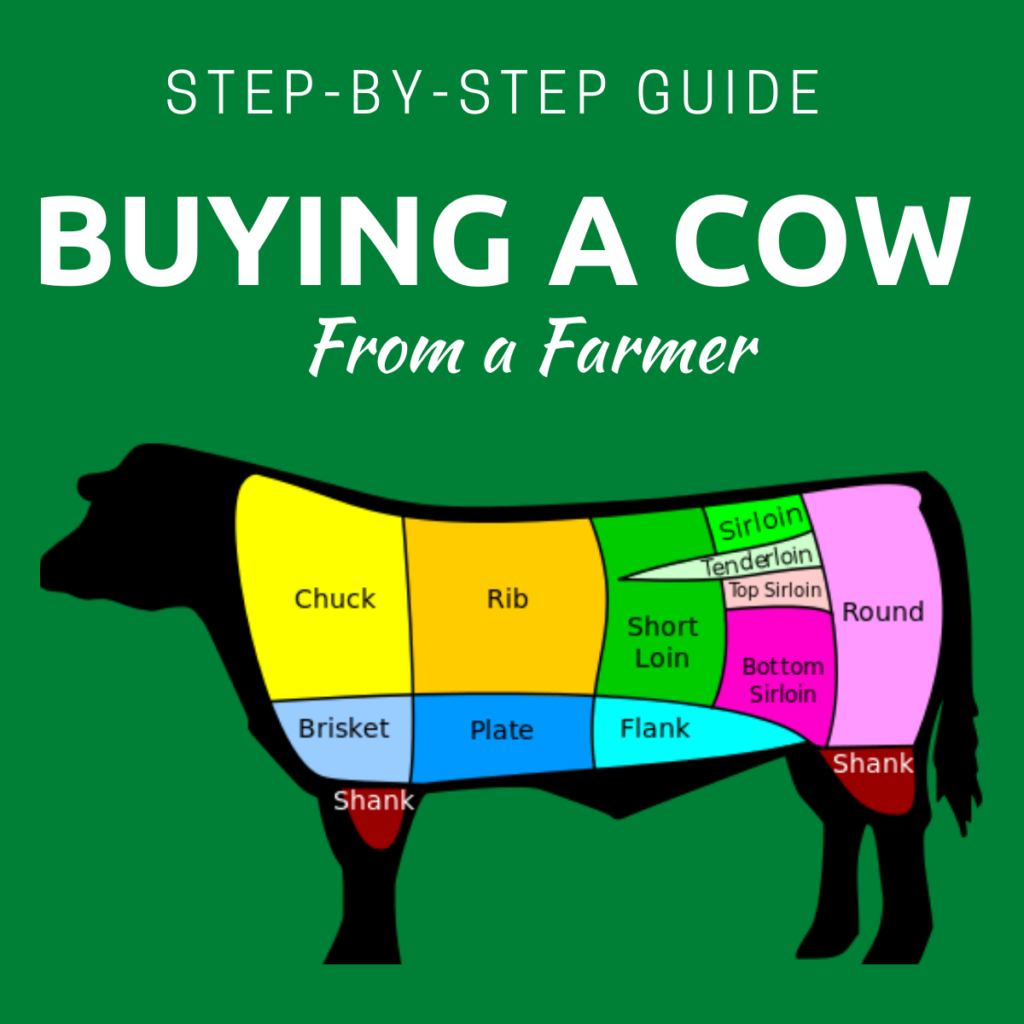
Are you thinking of buying a cow from a local farmer? That's a great idea because you'll get quality beef at a fraction of the price.
But, we know there are lots of other questions you need to ask too. We've been selling beef from our farm for over a decade, and we've answered hundreds of questions from customers.
In this step-by-step guide, we'll walk you through everything you need to know on buying a cow from a farmer. Here are a few things we'll cover:
- How do you find a farmer to purchase from?
- What questions should you ask before buying a cow?
- How do you make sure you're getting a good deal on beef?
- What type of beef should you get? grass fed? grass finished? grain? organic?
- How much beef will you actually get?
How do you buy a cow from a farmer? Where do you start?
Believe it or not, buying a cow is just like any other purchase. You make a decision by getting feedback from friends and family, local experts, and the internet.
Firstly, talk to family and friends and see if any of them have purchased a cow from a local farmer. If yes, did they have a good experience?
Secondly, visit your local farmers market. You'll likely find several beef farmers there, and you can talk to them and try a few steaks and ground beef before you purchase from them in bulk.
Another great resource is contacting your local Extension office or USDA office. You can ask for a recommendation of a local farmer that sells beef directly. If you've never heard of these offices before, do an online search for the closest one to you. You'll quickly see that these offices often partner with local universities and they offer lots of free information on a variety of topics — like buying a cow, planting a garden, running small business, and so much more.
And of course, there's always internet searches. Some sites aggregate local farmers, like EatWild or Local Harvest. These sites can be great, but keep in mind that farmers have to pay to be part of these sites. Therefore, the lists aren't all-inclusive.
Will you really save money buying a cow?
Yes! Depending on where you usually shop for beef and what type of beef you buy, you can save over $2,000 a year on beef.
We do price comparisons every year, and compare our beef prices to local St. Louis grocery stores. With Clover Meadows Beef, the price is approximately $5.45/pound for all cuts of grass fed beef. This is compared to $7.03/pound at Walmart, $7.84/pound at a local St. Louis grocery store, and $9.86/pound at Whole Foods.
What cuts of beef come with buying a cow?
- Steaks like filet, sirloin, ribeye, strip, skirt and flank
- Brisket
- Roasts like chuck, sirloin, arm
- Ground beef
- Ribs
- Stew meat
- Kabob meat
- Soup bones
- Organ meat (if desired)
- And the list keeps going on and on!
Depending on who you order your cow from, you'll get the option of customizing your cut list. More on that later.
At Clover Meadows Beef, if you order a sixteenth, quarter or a half beef, we use a standardized cut list since you're splitting the cow with other people and the entire cow needs to be processed the same way. If you order a whole cow, you can have it custom cut however you want.
Can my family really eat a whole cow? How much beef does a typical family eat in a year?
It varies by family. On average, our customers with a family of four eat about a half cow every year. Here's an easy formula that will help you figure it out:
My family usually eats ______ meals a week with 1 pound of beef
x
52 weeks a year
=
My family eats ________ pounds of beef per year.
Should the beef be inspected when buying a cow from a farmer?
All meat for public consumption in the U.S. must be inspected by the US Department of Agriculture (USDA). In some states, like Missouri, you can also have an inspector from a state inspection agency inspect meat, but state-inspected cannot cross state lines for sale.
USDA inspectors are very thorough, and the U.S. has the safest food supply of any country.
The USDA inspectors check the live animal to make sure they're healthy from head to hoof and treated humanely. They also inspect the slaughtering process, the animal's organs, the temperature of the meat, and make sure the carcass stays as clean as possible during the entire process.
If beef doesn't pass inspection, it is removed entirely from the food supply. When beef does pass inspection, it is stamped or labeled with the USDA inspection stamp, and that means it is fit to eat.
When buying a cow, should the beef be certified organic? Grass fed? Something else?
Having beef certified as organic or grass fed requires the farmer to have additional government inspections, file tons of paperwork and pay additional fees. It's a very expensive and long process.
Many farmers, like us, choose not to go through the process of having our beef certified as grass fed or organic. However, the beef often meets these qualifications.
When you're talking to the farmer you're considering buying beef from, ask them how they raise their cattle and if there are any standards they follow raising their cattle. How they raise their cattle is more important than a government label. Another way to ask this, is "what would the label say if you purchased their beef from a grocery store."
What's a cut list? How should the beef be cut when buying a cow?
The answer to this question varies by farm and beef processor. On our farm, we offer a standard cut list for sixteenth, quarter, and half orders, since it makes things sooooo much easier on our customers.
If you're working independently with a beef processor and butcher, there are a few things to keep in mind as you decide your cuts.
First, and most important, you have to remember a cow's anatomy, and that there is limited beef on a cow. Please stick with us through this section, because you need to know this to understand how your beef should be cut.
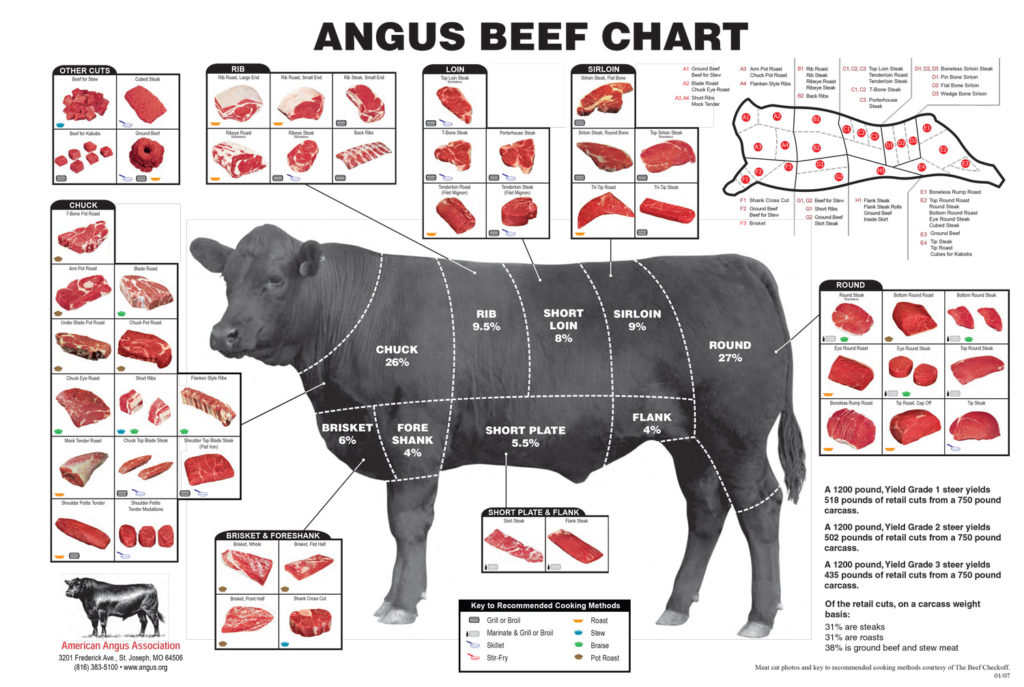
Eight Primal Beef Cuts
The USDA divides a cow into eight regions. These are known as the primal cuts, or the main cuts. Here are the eight primal cuts:
- Chuck
- Rib
- Loin
- Round
- Flank
- Short Plate
- Brisket
- Shank
Numerous different cuts can come from each of these sections. But if you're buying a quarter or half a cow, you're going to have to choose how that section is cut.
For example, at the grocery store you'll see "round" sold as ground beef, round steak, eye of round, tip steak, tip roast, top round and bottom round roasts. But, all of these round cuts come from numerous animals. When you're talking to the butcher, you'll need to choose a few ways to have the round cut. You can't do all of them that you see at a grocery store since there is a limited amount of beef on each animal.
Here are the beef cuts we recommend:
- Steaks: We like cutting steaks into 1-inch thickness. If you decide you want a thicker steak and your beef processor allows it, keep in mind you'll be getting fewer steaks. For example, if you order a quarter beef, you would usually get approximately 6-7 sirloin steaks if they're 1-inch thick. If you have them cut to 1 ½ -2 inches thick, you may only get 3-4 steaks. It's the same weight of beef, but how you have it cut makes a big difference on the quantity of steaks.
- Roasts: Arm, Chuck, Round, Rump cut into 3-4 pound roasts.
- Ground Beef: Packaged in 1 pound packages
- Short Ribs: You could have this ground into hamburger, but we don't recommend it. Short ribs are awesome.
- Stew Meat and/or Kabob Meat: These cuts are typically the trimmings from the steaks.
- Brisket: You could have this ground into ground beef, but please don't. Brisket is so good and there are lots of ways to cook brisket.
- Soup Bones: We love soup bones. They make the best bone broth. We highly recommend them.
- Organ meat: This is up to you, but we recommend it, especially liver.
What about T-Bone Steaks?
A comment we sometimes hear is that people want more unique cuts, like T-Bone, Porterhouse Steak, Delmonico Steak, Club Steak, etc.
The reason you don't see some of these cuts is two fold.
First, some cuts have different names based upon the region. For example a KC Strip and a NY Strip are essentially the same thing.
Second, other cuts are a combination of cuts. For example, a T-bone steak is a strip steak on one side and a tenderloin on the other. If you decide to cut the bone out, you would no longer have a T-bone. Instead, you would have two distinct cuts — a tenderloin (or filet) and a strip steak. And if it's an extremely large T-bone, it would be called a Porterhouse Steak, not a T-bone. According to the USDA, if the tenderloin section that is at least 1.25 inches across at the widest section, it's a porterhouse steak.
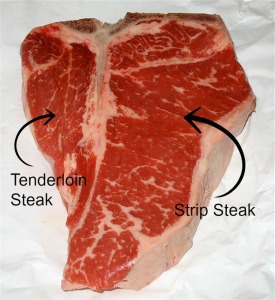
What's the difference between live weight, hanging weight and boxed weight?
At Clover Meadows Beef, our pricing is all-inclusive. We tell you what you'll get for a specific price, and that's what we deliver. We avoid terms like hanging weight because we think it's extremely confusing to those that are familiar with cattle.
However, if you're not in the St. Louis area and can't buy from our farm, you will likely be told an amount based on the weight of the animal or from one of the processing stages. Here are the terms you need to know so that you can calculate your actual cost:
- Live weight (or "on the hoof") is how much a cow weighs when it's alive and walking around.
- Hanging weight (or "on the rail") is after the animal is slaughtered and all the unusable parts are removed (like head, skin and hooves), Hanging weight includes bones and meat. Typically, the hanging weight is about 60% of the live weight.
- Boxed weight (or packaged weight) is the weight of all the packages of individual cuts of meat that you will put in your freezer This is typically about 60 percent of hanging weight.
An important thing to keep in mind if you're trying to figure out how much beef you'll actually get is that some of the weight is lost during each step of the process.
So, if you're trying to do math with a farmer that talks in hang weight – if they say it's $3.75 per pound hanging weight, then expect to pay $6.25 per pound ($3.75 / 0.60) PLUS the butchering fee, which is usually about $600.00 for the entire cow (you'll split this fee if you're sharing with another family).
If talking about hanging weight makes your head spin, order from us if you're in St. Louis or find another farm that prices beef as all-inclusive. It's much easier for everyone and you will know exactly what you're getting.
How should the beef be packaged if I buy a cow?
Most farmers will give you an option between paper, shrink wrapped, or vacuum sealing packaging. We recommend vacuum sealing because it will keep the beef fresh for longer.
Here's what a rib eye steak looks like from our farm.
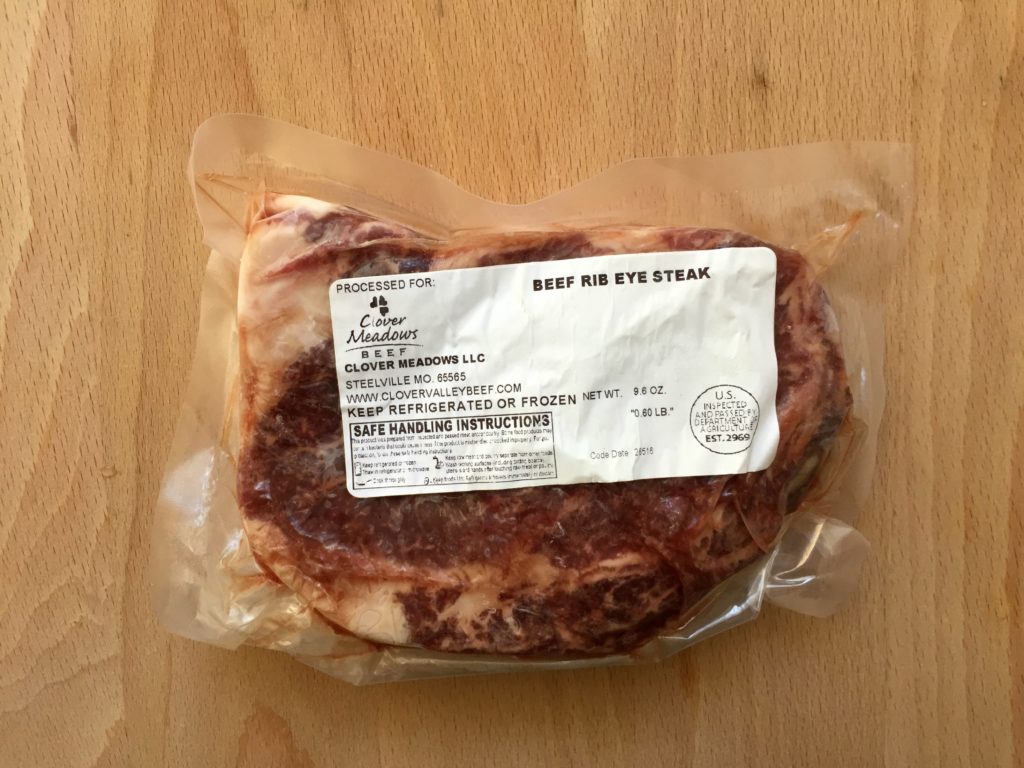
How much freezer space is needed when buying a cow?
Yes, you will most likely want a stand-alone freezer. The rule of thumb is 1 cubic foot of freezer space for every 30-35 lbs of cut and wrapped meat.
To help you visualize it, here's what our refrigerator looks like with a half a cow, about 220 pounds of beef.
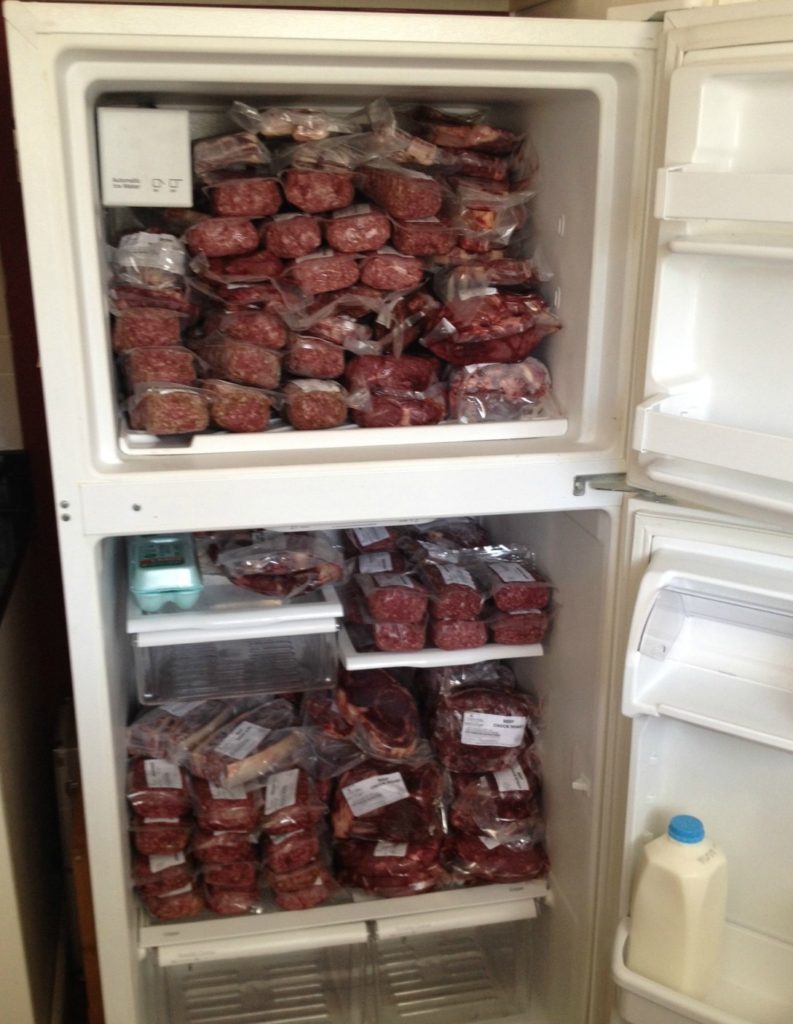
If you don't have a stand-alone freezer yet, you can usually get a good deal at a warehouse store like Sam's or Costco. We have both chest and upright freezers at our house and we like both of them.
Whatever you do, make sure you get one with a lock and key. This is very important for child safety reasons (children have climbed into freezers and suffocated) and because a physical lock will make sure your freezer is securely closed. You can also purchase an aftermarket lock.
If I have to buy a freezer, will I really save money in the long run?
A new 9 cubic foot freezer has a one-time cost of about $400-$450, and its yearly running cost will be approximately $38. So, as long as you continue to use your freezer in the future, buying one is a good investment for your beef, as well as whatever else you keep in your freezer.
How long will the beef last?
Approximately 1-year.
What questions should I ask a farmer when buying a cow?
We have a free tip-sheet to help you ask the right questions. There are 9 must-ask questions to make sure that you get the best deal, every time.
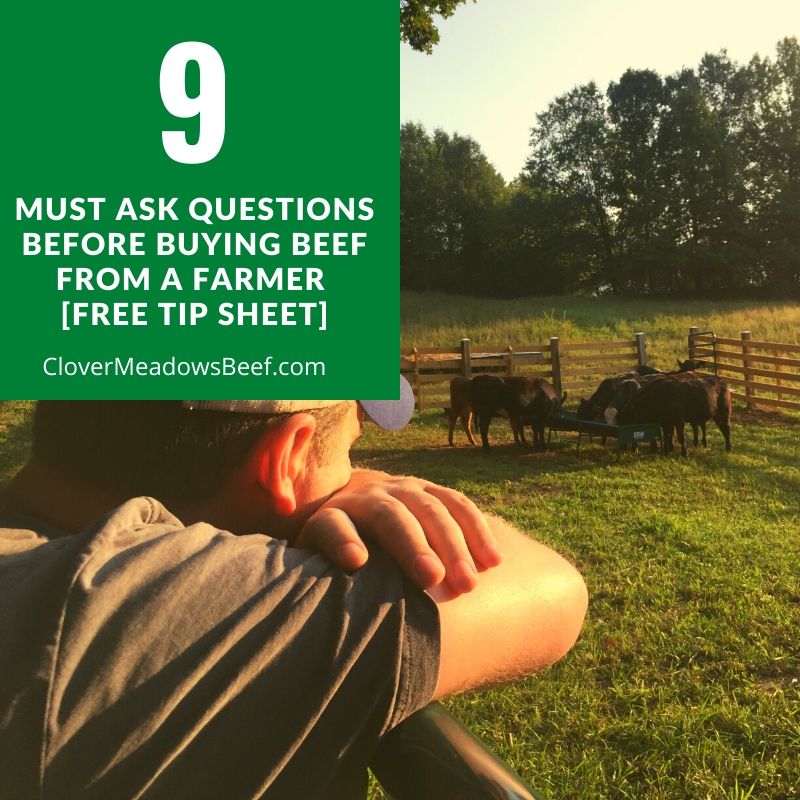
One more thing!
So, do you feel more prepared on buying a cow. We hope so! If you're in the St. Louis area and you want to order, let us know. Were here to help!
Do you want to learn more about beef? Here are a few other beef posts and recipes you may like. Plus, we have an entire ebook about beef that goes through purchasing and preparing beef from a farmers perspective.
And here are a few other blog posts you may like:
- What everybody ought to know about beef cuts
- Buying a Cow. How Much Beef Is It?
- Is It Done Yet? The Best Meat Thermometer
- How We Raise Our Grass Fed Beef
Pin it for later!
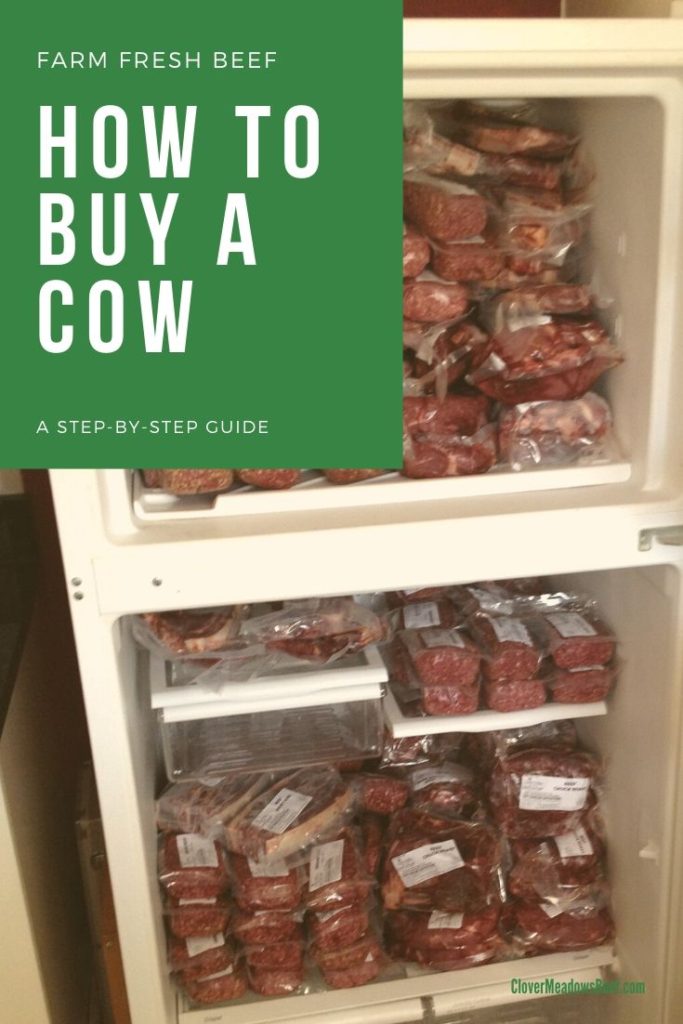
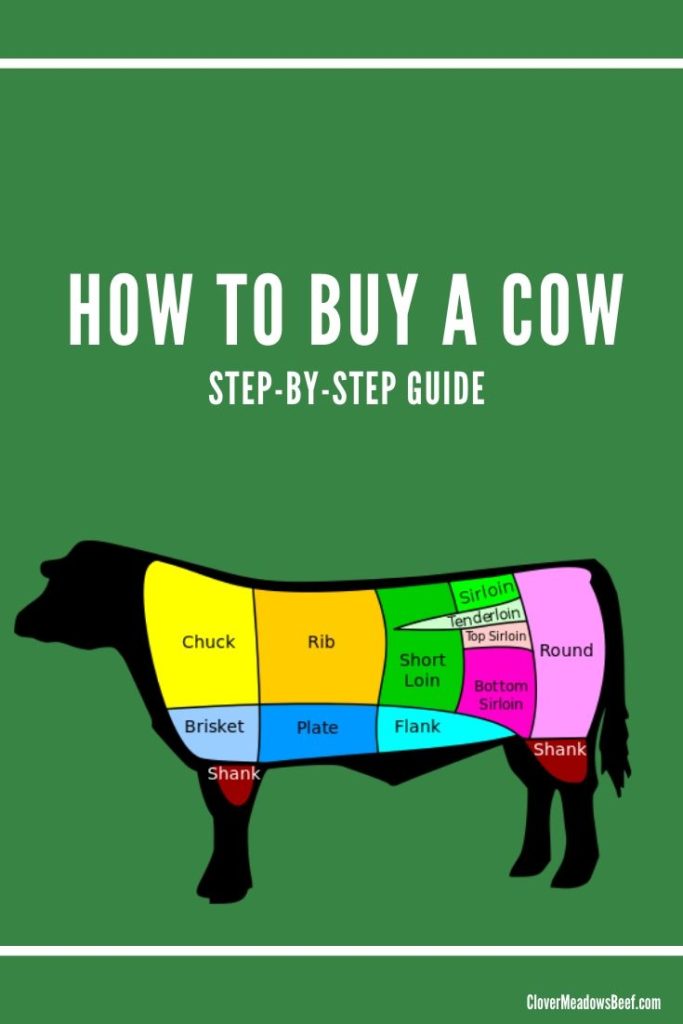
We participate in the Amazon Services LLC Associates Program, an affiliate advertising program designed to provide a means for us to earn fees by linking to Amazon.com and affiliated sites. See our disclosure policy for more details.
Source: https://www.clovermeadowsbeef.com/how-to-buy-a-cow-from-a-farmer/
0 Response to "Where to Buy Beef Plate Ribs Online"
Publicar un comentario